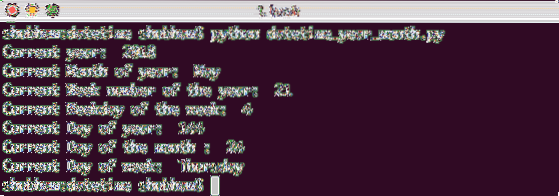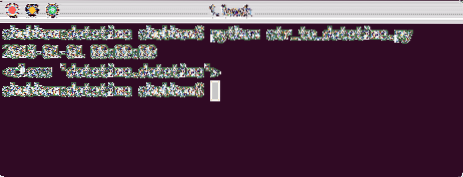Working with date and time objects is one of the most common tasks I have done in the Python utility scripts I write for file manipulations like finding files older than a given date & time etc. and in many other scripts. In this lesson, we will study some simple yet effective examples with Python datetime module which can be used to get the current date, formatting date strings, understanding a past date and much more. Let's get started.
We will work on some simple examples with Python datetime module in this section.
Python datetime now()
It is very easy to print the current date and time using the datetime module. Let's see an example here:
import timeimport datetime
print("Time since the epoch: %s", time.time())
print("Date and time now is: " , datetime.datetime.now())
Here is what we get back with this command:

Current time and date
I understand that accessing a property inside a module with same name as the module looks odd but it is what it is. It is important to note that date and time information is printed in a human-readable format.
Providing datetime format
We can also print the date and time information by passing a formatted string to strftime function as shown in the below sample progran:
import datetimeprint("Date in format : " , datetime.datetime.now().strftime("%y-%m-%d-%H-%M"))
Let's see the output for this command:

Formatted date and time
Using datetime variables
In this section, we will see how we can use many variables provided with the datetime module to access much granular information about current instance of time. Let's see a script which shows this information:
import datetimeprint("Current year: ", datetime.date.today().strftime("%Y"))
print("Current Month of year: ", datetime.date.today().strftime("%B"))
print("Current Week number of the year: ", datetime.date.today().strftime("%W"))
print("Current Weekday of the week: ", datetime.date.today().strftime("%w"))
print("Current Day of year: ", datetime.date.today().strftime("%j"))
print("Current Day of the month : ", datetime.date.today().strftime("%d"))
print("Current Day of week: ", datetime.date.today().strftime("%A"))
Here is what we get back with this command:

Current instance information
This shows how we can get specific details about the variables for date and time objects.
Getting Weekday for a Date
If we want to work with a past date (or even a future one), we can easily do this by passing the day, month and year of the date we want to work with in the date function:
import datetimesome_day = datetime.date(1994,5, 20) #year, month, day
print(some_day.strftime("%A"))
Let's see the output for this command:

Certain date instance
Converting String to datetime
It is easy to convert a String to a datetime object by passing the date and the format with which this date should be interpreted:
import datetimenow = datetime.datetime.strptime("1/1/2018", "%m/%d/%Y")
print(now)
print(type(now))
Here is what we get back with this command:

Converting string to date
Conclusion
In this lesson, we looked at how we can make use of Python's datetime module to make date objects much usable and flexible when we want to manipulate some data.
Read more Python based posts here.
 Phenquestions
Phenquestions


